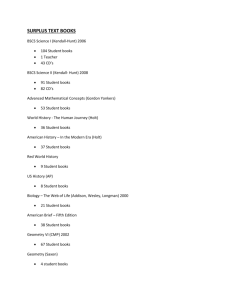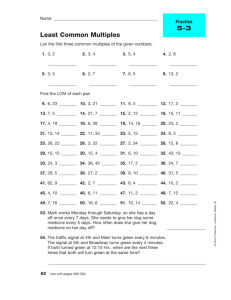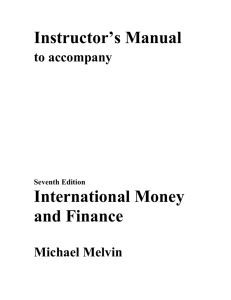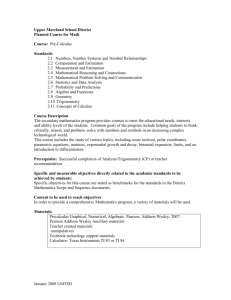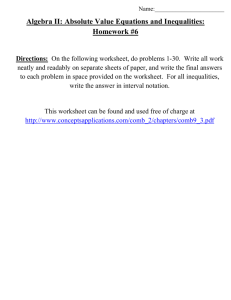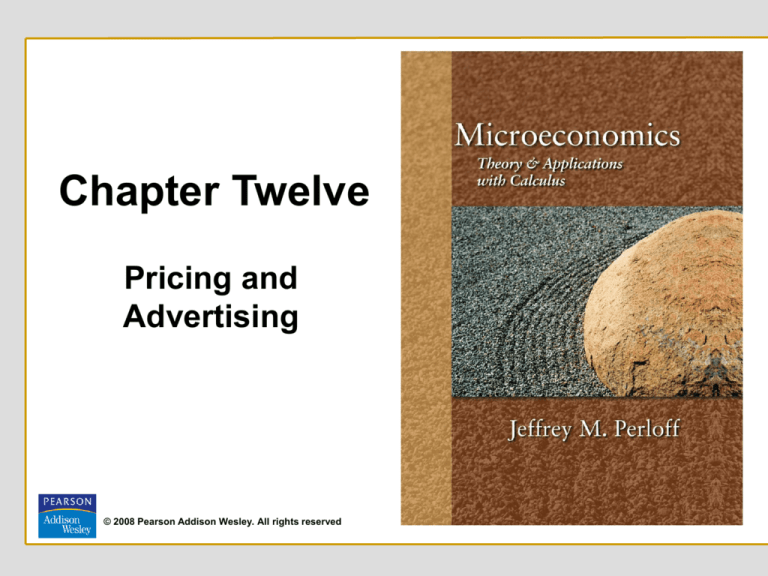
Chapter Twelve
Pricing and
Advertising
© 2008 Pearson Addison Wesley. All rights reserved
Pricing
• Monopolies (and other noncompetitive firms)
can use information about individual
consumer’s demand curve to increase their
profits.
• Instead of setting a single price, such firms
use nonuniform pricing.
© 2008 Pearson Addison Wesley. All rights reserved.
12-2
Pricing
• Nonuniform Pricing
– Charging consumers different prices for
the same product or charging a single
customer a price that depends on the
number of units the customer buys
• Price Discrimination
– Practice in which a firm charges
consumers different prices for the same
good
© 2008 Pearson Addison Wesley. All rights reserved.
12-3
Pricing
• In this chapter, we examine seven main
topics
– Why and How Firms Price Discriminate
– Perfect Price Discrimination
– Quantity Discrimination
– Multimarket Price Discrimination
– Two-Part Tariffs
– Tie-In Sales
– Advertising
© 2008 Pearson Addison Wesley. All rights reserved.
12-4
Why and How Firms Price
Discriminate
• Why Price Discrimination Pays
– For almost any good or service, some
consumers are willing to pay more than
others.
© 2008 Pearson Addison Wesley. All rights reserved.
12-5
Why Price Discrimination Pays
• A firm earns a higher profit from price
discrimination than from uniform pricing for
two reasons.
• First, a price-discrimination firm charges a
higher price to customers who are willing to
pay more than the uniform price, capturing
some or all of their consumer surplus.
© 2008 Pearson Addison Wesley. All rights reserved.
12-6
Why Price Discrimination Pays
• Second, a price-discrimination firm sells to
some people who were not willing to pay as
much as the uniform price.
© 2008 Pearson Addison Wesley. All rights reserved.
12-7
Who Can Price Discriminate
• For a firm to price discriminate successfully,
three conditions must be met.
• First, a firm must have market power.
• Second, consumers must differ in their
sensitivity to price (demand elasticities), and
a firm must be able to identify how
consumers differ in this sensitivity.
© 2008 Pearson Addison Wesley. All rights reserved.
12-8
Who Can Price Discriminate
• Third, a firm must be able to prevent or limit
resales to higher-price-paying customers by
customers whom the firm charges relatively
low prices.
© 2008 Pearson Addison Wesley. All rights reserved.
12-9
Preventing Resales
• Resales are difficult or impossible for most
services and when transaction costs are high.
• Some firms act to raise transaction costs or
otherwise make resales difficult.
• A firm can prevent resales by vertically
integrating: participating in more than one
successive stage of the production and
distribution chain for a good or service.
© 2008 Pearson Addison Wesley. All rights reserved.
12-10
Types of Price Discrimination
• Perfect price discrimination (first-degree
price discrimination)
• Quantity discrimination (second-degree price
discrimination)
• Multimarket price discrimination (thirddegree price discrimination)
© 2008 Pearson Addison Wesley. All rights reserved.
12-11
Perfect Price Discrimination
• A situation in which a firm sells each unit at
the maximum amount any customer is willing
to pay for it, so prices differ across
customers and a given customers may pay
more for some units than for others.
© 2008 Pearson Addison Wesley. All rights reserved.
12-12
Perfect Price Discrimination
• If a firm with market power knows exactly
how much each customer is willing to pay for
each unit of its good and it can prevent
resales, the firm charges each person his or
her reservation price: the maximum amount
a person would be willing to pay for a unit of
output.
© 2008 Pearson Addison Wesley. All rights reserved.
12-13
Figure 12.1
Perfect Price Discrimination
© 2008 Pearson Addison Wesley. All rights reserved.
12-14
Perfect Price Discrimination
• A perfectly price-discriminating monopoly’s
marginal revenue is the same as its price.
• As the figure shows, the firm’s marginal
revenue is MR1 $6 on the first unit,
MR2 $5 on the second unit, and MR3 $4 on
the third unit.
• As a result, the firm’s marginal revenue
curve is its demand curve.
© 2008 Pearson Addison Wesley. All rights reserved.
12-15
Perfect Price Discrimination:
Efficient but Harmful to
Consumers
• A perfect price discrimination equilibrium is
efficient and maximizes total welfare, where
welfare is defined as the sum of consumer
surplus and producer surplus.
• As such, this equilibrium has more in
common with a competitive equilibrium than
with a single-price-monopoly equilibrium.
© 2008 Pearson Addison Wesley. All rights reserved.
12-16
Figure 12.2
Competitive, Single-Price, and Perfect
Discrimination Equilibria
© 2008 Pearson Addison Wesley. All rights reserved.
12-17
Figure 12.2 Competitive, Single-Price,
and Perfect Discrimination Equilibria
• In the competitive market equilibrium,ec ,
price is pc , quantity is Qc, consumer
surplus is A B C, producer surplus
is D E , and there is no deadweight loss.
• In the single-price monopoly equilibrium,
es , price is ps , quantity is Qs , consumer
surplus falls to A , producer surplus
is B D , and deadweight loss is C E.
© 2008 Pearson Addison Wesley. All rights reserved.
12-18
Figure 12.2 Competitive, Single-Price,
and Perfect Discrimination Equilibria
• In the perfect discrimination equilibrium, the
monopoly sells each unit at the customer’s
reservation price on the demand curve.
• It sells Qd ( Qc ) units, where the last unit is
sold at its marginal cost.
• Customers have no consumer surplus, but
there is no deadweight loss.
© 2008 Pearson Addison Wesley. All rights reserved.
12-19
Equation 12.1
© 2008 Pearson Addison Wesley. All rights reserved.
12-20
Equation 12.2
© 2008 Pearson Addison Wesley. All rights reserved.
12-21
Equation 12.3
© 2008 Pearson Addison Wesley. All rights reserved.
12-22
Transaction Costs and Perfect
Price Discrimination
• Transaction costs are a major reason why
these firms do not perfectly price
discriminate: It is too difficult or costly to
gather information about each customer’s
price sensitivity.
© 2008 Pearson Addison Wesley. All rights reserved.
12-23
Transaction Costs and Perfect
Price Discrimination
• Many other firms believe that, taking the
transaction costs into account, it pays to use
quantity discrimination, multimarket price
discrimination, or other nonlinear pricing
methods rather than try to perfectly price
discriminate.
© 2008 Pearson Addison Wesley. All rights reserved.
12-24
Quantity Discrimination
• A situation in which a firm charges a different
price for large quantities than for small
quantities but all customers who buy a given
quantity pay the same price.
© 2008 Pearson Addison Wesley. All rights reserved.
12-25
Quantity Discrimination
• Most customers are willing to pay more for
the first unit than for successive units: The
typical customer’s demand curve is
downward sloping.
• The price varies only with quantity: All
customers pay the same price for a given
quantity.
© 2008 Pearson Addison Wesley. All rights reserved.
12-26
Figure 12.3
Quantity Discrimination
© 2008 Pearson Addison Wesley. All rights reserved.
12-27
Figure 12.3 Quantity Discrimination
•
If this monopoly engages in quantity
discounting, it makes a larger profit
(producer surplus) than it does if it sets a
single price, and welfare is greater.
© 2008 Pearson Addison Wesley. All rights reserved.
12-28
Figure 12.3 Quantity Discrimination
a) With quantity discounting, profit is
B $1, 200 and welfare is A B C $1, 600 .
b) If it sets a single price (so that its marginal
revenue equals its marginal cost), the
monopoly’s profit is F $900, and welfare
is E F $1,350 .
© 2008 Pearson Addison Wesley. All rights reserved.
12-29
Multimarket Price Discrimination
• A situation in which a firm charges different
groups of customers different prices but
charges a given customer the same price for
every unit of output sold.
© 2008 Pearson Addison Wesley. All rights reserved.
12-30
Multimarket Price Discrimination
with Two Groups
• How does a monopoly set its prices if it sells
to two (or more) groups of consumers with
different demand curves and if resales
between the two groups are impossible?
© 2008 Pearson Addison Wesley. All rights reserved.
12-31
Multimarket Price Discrimination
with Two Groups
• Because the monopoly equates the marginal
revenue for each group to its common
marginal cost, MC m, the marginal
revenues for the two countries are equal:
MRA m MRB
© 2008 Pearson Addison Wesley. All rights reserved.
12-32
Multimarket Price Discrimination
with Two Groups
• Rewriting Equation 12.1 using these
expressions for marginal revenue, we find that
1
1
MRA pA 1 m pB 1 MRB (12.8)
A
B
• The ratio of prices in the two countries
depends only on demand elasticities in those
countries:
PC 1 1/ US
(12.9)
pUS
© 2008 Pearson Addison Wesley. All rights reserved.
1 1/ C
12-33
Equation 12.4
© 2008 Pearson Addison Wesley. All rights reserved.
12-34
Equation 12.5
© 2008 Pearson Addison Wesley. All rights reserved.
12-35
Equation 12.6
© 2008 Pearson Addison Wesley. All rights reserved.
12-36
Equation 12.7
© 2008 Pearson Addison Wesley. All rights reserved.
12-37
Figure 12.4
Multimarket Pricing of Harry Potter DVD
© 2008 Pearson Addison Wesley. All rights reserved.
12-38
Identifying Groups
• Firms use two approaches to divide
customers into groups.
• One method is to divide buyers into groups
based on observable characteristics of
consumers that the firm believes are
associated with unusually high or low price
elasticities.
© 2008 Pearson Addison Wesley. All rights reserved.
12-39
Identifying Groups
• Another approach is to identify and divide
consumers on the basis of their actions: The
firm allows consumers to self-select the
group to which they belong.
© 2008 Pearson Addison Wesley. All rights reserved.
12-40
Welfare Effects of Multimarket
Price Discrimination
• Multimarket price discrimination results in
inefficient production and consumption.
• As a result, welfare under multimarket price
discrimination is lower than that under
competition or perfect price discrimination.
© 2008 Pearson Addison Wesley. All rights reserved.
12-41
Multimarket Price Discrimination
Versus Competition
• Consumer surplus is greater and more
output is produced with competition (or
perfect price discrimination) than with
multimarket price discrimination.
© 2008 Pearson Addison Wesley. All rights reserved.
12-42
Multimarket Price Discrimination
Versus Single-Price Monopoly
• From theory alone, we can’t tell whether
welfare is higher if the monopoly uses
multimarket price discrimination or if it sets a
single price.
• Both types of monopolies set price above
marginal cost, so too little is produced
relative to competition.
© 2008 Pearson Addison Wesley. All rights reserved.
12-43
Multimarket Price Discrimination
Versus Single-Price Monopoly
• The closer the multimarket-pricediscriminating monopoly comes to perfectly
price discrimination (say, by dividing its
customers into many groups rather than just
two), the more output it produces, so the less
the production inefficiency there is.
© 2008 Pearson Addison Wesley. All rights reserved.
12-44
Two-Part Tariffs
• Two-part tariff
– A pricing system in which the firm charges
a customer a lump-sum fee (the first tariff
or price) for the right to buy as many units
of the good as the consumer wants at a
specified price (the second tariff).
© 2008 Pearson Addison Wesley. All rights reserved.
12-45
A Two-Part Tariff with Identical
Consumers
• If all the monopoly’s customers are identical,
a monopoly that knows its customers’
demand curve can set a two-part tariff that
has the same two properties as the perfect
price discrimination equilibrium.
© 2008 Pearson Addison Wesley. All rights reserved.
12-46
A Two-Part Tariff with Identical
Consumers
• First, the efficient quantity, Q1 , is sold
because the price of the last unit equals
marginal cost.
• Second, all consumer surplus is transferred
from consumers to the firm.
© 2008 Pearson Addison Wesley. All rights reserved.
12-47
Figure 12.5
Two-Part Tariff
© 2008 Pearson Addison Wesley. All rights reserved.
12-48
Figure 12.5 Two-Part Tariff
• Two-part tariff
– If all consumers have the demand curve in
panel a, a monopoly can capture all the
consumer surplus with a two-part tariff by
which it charges a price, p , equal to the
marginal cost, m $10 , for each item and a
lump-sum membership fee
of L A B C $2, 450 .
1
1
© 2008 Pearson Addison Wesley. All rights reserved.
1
12-49
A Two-Part Tariff with Nonidentical
Consumers
• If the monopoly can treat its customers
differently, it maximizes its profit by setting
p m $10 and charging Consumer 1 a fee
equal to its potential consumer
surplus, A1 B1 C1 $2, 450 , and
Consumer 2 a fee of A2 B2 C2 $4,050 , for
a total profit of $6,500.
© 2008 Pearson Addison Wesley. All rights reserved.
12-50
A Two-Part Tariff with Nonidentical
Consumers
• If the monopoly must charge all consumers
the same price, it maximizes its profit at
$5,000 by setting p $20 and charging both
customers a lump-sum fee equal to the
potential consumer surplus of Consumer
1, L A1 $1,800 .
© 2008 Pearson Addison Wesley. All rights reserved.
12-51
Tie-In Sales
• Tie-in sale
– A type of nonlinear pricing in which
customers can buy one product only if
they agree to buy another product as well.
© 2008 Pearson Addison Wesley. All rights reserved.
12-52
Tie-In Sales
• Requirement tie-in sale
Consumers who buy one product from a
firm are required to make all their purchases
of another product from that firm.
• Bundling (package tie-in sale)
– A type of tie-in sale in which two goods are
combined so that customers cannot buy
either good separately.
© 2008 Pearson Addison Wesley. All rights reserved.
12-53
Advertising
• One of the most important decision that a
monopoly has to make is how much to
advertise.
• A successful promotional campaign shifts
the monopoly’s demand curve by changing
consumers’ tastes or informing consumers
about new products.
© 2008 Pearson Addison Wesley. All rights reserved.
12-54
The Decision Whether to
Advertise
• If advertising shifts demand outward or
makes it less elastic, the firm’s gross profit,
which ignores the cost of advertising, must
rise.
• The firm undertakes this advertising
campaign, however, only if it expects its net
profit (gross profit minus the cost of
advertising) to increase.
© 2008 Pearson Addison Wesley. All rights reserved.
12-55
Figure 12.6
Advertising
© 2008 Pearson Addison Wesley. All rights reserved.
12-56
How Much to Advertise
• How much should a monopoly advertise to
maximize its net profit?
• A monopoly sets its quantity, Q, and level of
advertising, A to maximize its profit as
shown in equation (12-10).
© 2008 Pearson Addison Wesley. All rights reserved.
12-57
Equation 12.10
© 2008 Pearson Addison Wesley. All rights reserved.
12-58
Equation 12.11
© 2008 Pearson Addison Wesley. All rights reserved.
12-59
Equation 12.12
© 2008 Pearson Addison Wesley. All rights reserved.
12-60

